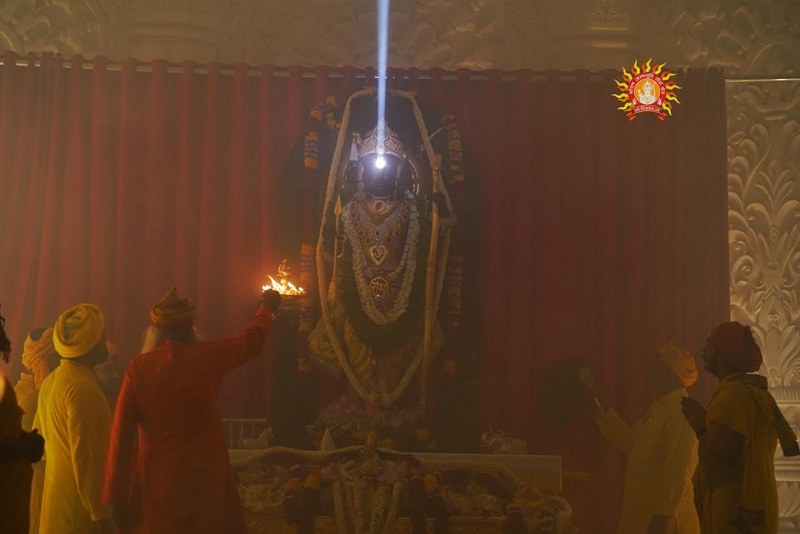 Surya Tilak
Surya Tilak
Know how the Indian Institute of Astrophysics brought the sunlight on Ram Lalla's forehead in Ayodhya
Indian Institute of Astrophysics (IIA), an autonomous body under the Department of Science and Technology, played a crucial role in the Surya Tilak Project at Ayodhya.
The 'Surya Tilak' or Sun's rays illuminated Ram Lalla idol's forehead in the Ram Temple on the occasion of Ram Navami on Wednesday. The illumination occurred with the help of mirrors and lenses.
According to a government release, under the Surya Tilak project, sunlight was brought on the forehead of the idol of Ram Lalla at 12 noon on the occasion of Sri Ram Navami in the Chaitra month.
IIA team carried out the calculation of the sun position, design and optimisation of the optical system, and performed the integration and alignment at the site.
The English calendar date of Sri Ram Navami festival changes every year as it follows the Lunar Calendar. Therefore, the position of the sun on the sky changes every year on the day of Sri Ram Navami. Detailed calculations show that the English calendar date of Sri Ram Navami repeats every 19 years. Calculating the position of the sun in the sky on these days requires expertise in astronomy.
 The 'Surya Tilak' or Sun's rays illuminated the forehead of the Ram Lalla idol. Photo credit: Shri Ram Janmbhoomi Teerth Kshetra
The 'Surya Tilak' or Sun's rays illuminated the forehead of the Ram Lalla idol. Photo credit: Shri Ram Janmbhoomi Teerth Kshetra
The IIA team led the calculation for identification of the calendar days of Sri Ram Navami for one cycle of 19 years followed by its repetition, estimation of the position in the sky on the calendar dates of the Ram Navami.
They also led the design of an opto-mechanical system to bring the sunlight from the top of the temple to the forehead of the idol, estimation of the size, shape and location of mirrors and lenses in the system for sufficient light to fall on the idol for about 6 minutes, opto-mechanical design of the lens and mirror holder assembly, and the manual mechanism to shift the position of the first mirror according to the position of the Sun in the sky.
Crucial design optimisation as well as simulations were carried out to arrive at various quantities in the opto-mechanical design as well as the functioning of the mechanism.
As the temple is not fully complete now, the IIA experts modified the design to suit the existing structure and performed image optimisation. This design, with 4 mirrors and 2 lenses, was executed for the Surya Tilak on April 17.
 PM Modi watches Ayodhya temple Surya Tilak on tab. / Photo: BJP FB
PM Modi watches Ayodhya temple Surya Tilak on tab. / Photo: BJP FB
The IIA technical experts participated in the testing, assembly, integration and validation of the system at site. The crucial alignment of the mirrors and lenses were performed by the technical experts from IIA during the trial runs in the Ram Mandir prior to the first Surya Tilak on 17th April 2024.
At the site, the implementation of the opto-mechanical system is done by CBRI. The device is manufactured by Optics, Bangalore.
The final design of the Surya Tilak with 4 mirrors and 4 lenses, will be implemented once the full temple is constructed, by placing the mirrors and lenses in their permanent fixtures.The above mechanism was designed to work even if there is a shift of 1-2 days in the calendar date of the Ram Navami.
A change will alter the duration of the spot on the idol. The mechanism will not work if there is no sunlight due to clouds or rain. An annual shift of the first mirror has to be performed manually before Ram Navami every year. The lenses and mirrors mounted on holders are accessible and can be cleaned periodically.
The device has been manufactured by Optica, Bangalore & implementation of the opto-mechanical system at the site is being done by CSIR-CBRI.
Support Our Journalism
We cannot do without you.. your contribution supports unbiased journalism
IBNS is not driven by any ism- not wokeism, not racism, not skewed secularism, not hyper right-wing or left liberal ideals, nor by any hardline religious beliefs or hyper nationalism. We want to serve you good old objective news, as they are. We do not judge or preach. We let people decide for themselves. We only try to present factual and well-sourced news.







